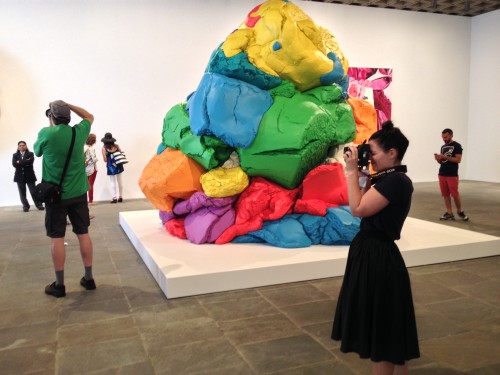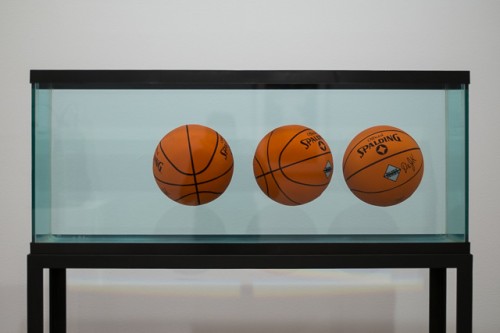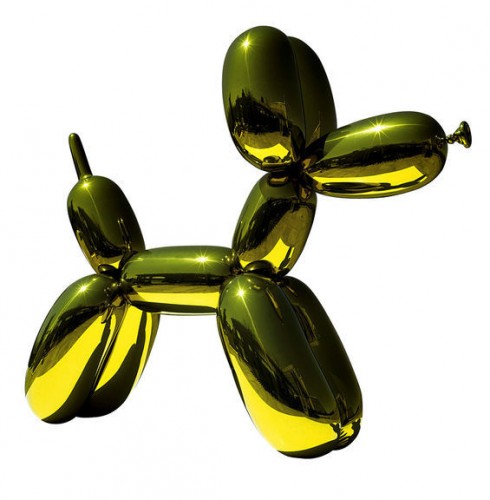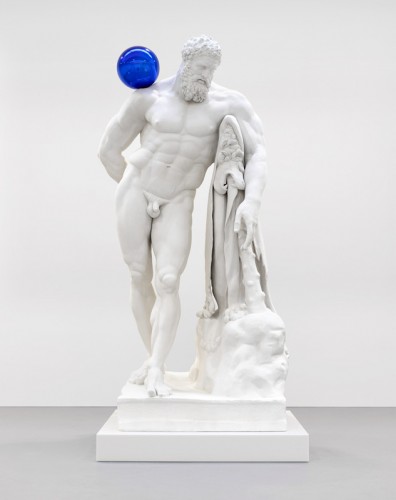[contextly_auto_sidebar id=”UcPPC0IsMBsraAR46tbTAK9OiyPbV3gi”]
Pop Art Comeback
Announce that you like Jeff Koons and they’ll think you’re crazy or a capitalist running-dog lackey. Say you hate him and you’re just another anti-capitalist snooty spoilsport, without a sense of irony. So the best thing to do might be to avoid the big, expensive show of his shiny, expensive art now at the Whitney. After all, everyone has already seen most of the stuff; everyone has already decided what to think, what to say.
But then you run the risk of being accused of cowardice.
We don’t want black or white; we want nuance.
After listening to me complain about the art world on the telephone one night, Andy Warhol told me: Well, you know, John, it is always better to like things. Was he right? What would he think of Koons? Did Koons become the next Andy Warhol, or merely Warhol minus the darkness?
The soup cans and Brillo boxes must have been an influence, yes. But you will find nothing in Koons equivalent to the silkscreen painting of the deadly tuna fish cans, the car crashes, or even the mourning Jackie. If Koons is a latter-day Warhol, he is a Warhol without shadows. If he is not totally a latter-day Oldenburg, it is because he did not have a trusty wife to do all that sewing for him. Instead, although there is no sewing done, he has many paid accomplices to mold, paint, polish, or whatever is required to achieve those merciless surfaces, that gloss, that perfect finish. Koons would never go soft. The recent inflatables look soft but they are as hard as steel. Don’t count on these floats to save you from drowning in your infinity pool.
My best Koons story is that my beloved and I did see the now famous Koons show in 1985 at International With Monument in the East Village. And we both agreed that the floating basketball was pretty swell. We debated for days about buying it. We actually then could have afforded it: it was priced that low. We decided not to and have been kicking ourselves ever since.
My old friend Lil Picard had a similar experience with an affordable Pollock in his first show with Betty Parsons. Lil, the ex-Weimar coffeehouse girl and then New World destruction artist, actually left the opening reception and walked around the block between Fifth and Sixth Avenue several times. Fifty-seventh Street has very long blocks. She didn’t buy it. This is not to even hint that Koons is as great as Pollock.
These are just two stories with the same moral: You indeed can dine on regrets.
Stories are important. Looks too. Andy proved that with his wig. Joseph Beuys also had a look, so later, whimsical James Lee Byars (now at MoMA/ P.S.1) had to have a look. Marina, after a certain point, needed one also. And Koons, the man with the permanent smile, had to remake himself, too.
Recently I had to appear in public in my artist persona. I am not sure I have quite acquired one yet, so I turned the whole appearance into a performance. Remembering that Andy occasionally hired an actor to impersonate him when he had a gig he didn’t want to go to, I decided to pretend I was an actor hired by John Perreault to impersonate me. It was one of my Secret Artworks. I kept myself interested in my Performance by constantly hinting to people that I was not me but an actor who had been paid to imitate Perreault for the evening.
And then, in an ultra-Hitchcock turn, you become the person who is impersonating you. Or even more scary, he or she becomes you permanently, and you are cast aside, a mere nobody.
The New Is Now Old Hat
We actually braced ourselves and looked at the art. Again.
You should learn something by seeing all the Koonsiana together, right? I will summarize by saying that some things are better than others. The suspended basketballs and the encased vacuum cleaners are topnotch. The 2D works are uniformly awful — photorealist montages of Tom Wesselmann, Jim Rosenquist, Audrey Flack, with a little bit of Picabia double-exposure overlays, via David Salle, thrown in for good measure. The gazing balls plus classic statuary recently foisted upon the wary public are good, but at Rockefeller Center the new ersatz topiary is not as charming as the puppy was. Popeye in any form doesn’t work. Porn in any form, either.
Or just this:
The balloon dog – in any size, any color — is not Meta Art, but it is also not Almost Art. It is something else. A kind of stand-in for art, which is quite an accomplishment, if you think about it. The new, new, new Play-Doh is a play on words, equivalent to Warhol’s silkscreened money.
But I recommend you first see the Duchamp multiples, thoughtfully mounted at Gagosian a block uphill from the Whitney. Yes, it is the 100th anniversary of the first readymade. I myself am going to be in a show of readymades called “The Readymade@100” this fall at the American University in D.C. Not me personally, but a readymade by me.
But just so you won’t forget that Jeff Koons is having his big moment down the road, there’s also a small show of recent Koons “Inflatable” multiples at Gag Mad.
So you won’t forget Koons’ debt to Marcel?
In the beginning, St. Marcel unintentionally generated Pop by influencing Jasper and Bob who influenced Andy, and so forth. Lineage is as important in art as it is in royalty or among the Hasidim or Mohammedans. The great mystical story-teller Rabbi Nachman, grandson of the Baal Shem Tov, is called the “dead rabbi” because he left no descendants.
Dough-Re-Mi or Moola Hula
And then there is the matter of m.o.n.e.y.
I recently joked that the Whitney Madison Avenue building would make an ideal flagship store for the Gagosian Empire. And now it is. Gagosian is actually listed on a wall text thanking corporate sponsors:
Leadership support for this exhibition is provided by
GAGOSIAN GALLERY
I always assumed galleries covered shipping and helped out with contacting owners of artworks needed. I am not sure what “leadership support” means. But it takes m.o.n.e.y. to mount an art exhibition. I have often thought that those who profit should pay. On the other hand, although museum shows once generated sales, I doubt that is the case now. Prestige now wears a different mink coat.
We have long cherished Thorstein Veblen. We cannot understand postmodern life without his concept of “conspicuous consumption.” Conspicuous consumption transcends premodern, modern and postmodern. When an artwork becomes so expensive that nearly everyone has to mention how much it now costs, we are no longer dealing with an artwork; we are dealing with a symbol. You bought this Koons to prove to everyone that you have enough money to buy this Koons. Therefore, you are clever, talented and certainly rich, rich, rich.
I think you should buy art only if you can’t afford it, but simultaneously cannot live without it. Certainly not to flip it for quick profit or use it as an advertisement for yourself or some building you want to rent out. You thereby risk financial disaster, weird diseases, genital disfigurement, sterility and the sudden death of your grandchildren at the hands of the Art Furies. You heard it here first.
And if you as an artist are making stuff only to satisfy a market … well, you are just doing what artists have always done. If no one buys your art, who will save it for posterity? For a sense of balance, however, just think of Rosa Bonheur (1822-1899). Her dreadful horse paintings once fetched the highest prices for a living artist, and who cares about them now?
Day of Judgment
The takeaway: Koons is as good as Oldenburg, but not as good as Warhol.
Why didn’t everyone see that Koons was a Pop artist way back when? And why don’t they see it and say it now? He was associated with Neo-Geo, whatever that was, but merely because he debuted in the same gallery – the aforementioned International With Monument — with several other artists who could also be better seen as Pop.
Big bad Pop had gone away.
No, it merely was in occultation. And was called by another name. The art world was suffering from a failure of nomenclature. Should we have called Koons Neo-Pop? Can we call him that now? No one wants to be a Neo anything. And no one wants to be cursed with the Second Generation label, right? Just look at all those poor, poor artists – some of whom were actually quite good — tarred with the rubric “Second Generation New York School.” Everyone wants to be one of the originals.
New sells. New art must have a new name.
But Pop Art never went away. After Warhol, Lichtenstein, Oldenburg, Indiana, Rosenquist, we had Barbara Kruger, Jeff Koons, Meyer Vaisman (whose recent two-gallery show in the Lower East Side was a timely reminder of how smart and talented he is), Ashley Bickerton, Peter Halley, Haim Steinbach, etc.
Is This the End?
The Jeff Koons show at the Whitney on Madison Avenue is the last show there. Is the move to the Meatpacking District the end of an era, appropriately marked, or merely a real estate ploy? When the move was announced, the rent for a gallery in the Meatpacking District quadrupled.
I should be sad but I am not. As usual, I greet the future with my tongue in my cheek.
Think of all the great solo shows in the strangely unloved Marcel Breuer building: H.C. Westermann, Chuck Close, Nam June Paik, Richard Tuttle, Andy Warhol. The Whitney has come a long way. The Mad Ave venue opened with Louise Nevelson, Andrew Wyeth and Mauricio Lasansky. Something for everyone — which is always a big mistake. And the Biennials and all the other terrible exhibitions will be forgotten. Name four really awful exhibitions at the Whitney. See what I mean?
And the Whitney, I predict, will be up to its old tricks. The new space at the end of the High-Line Park opens this fall with Archibald Motley, Frank Stella (?), Laura Poitras, and David Wojnarowicz (!).
John Perreault is on Facebook, specializing in neo-modern, small-scale residential architecture. Links here for John Perreault’s website & John Perreault’s art.
John Perreault videos: http://tinyurl.com/n6x848h





